Al Gore "An Inconvenient Truth"

Part 5 (54:37 - 1:01:37) 
Al Gore "An Inconvenient Truth" |
 |
Part 5 (54:37 - 1:01:37) |
|
|
|
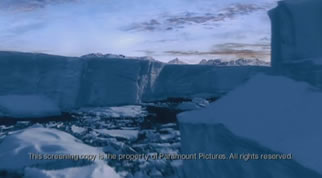 |
The Second Canary: Antarctic Peninsula Sea Ice This brings me to the second canary in the coal mine, Antarctica, the largest mass of ice on the planet by far. A friend of mine said in 1978, “If you see the break up of ice shelves along the Antarctic Peninsula, watch out, because that should be seen as an alarm bell for global warming." If you look at the peninsula up close, every place where you see one of these green blotches is an ice shelf larger than the state of Rhode Island that has broken up in just the last 15 to 20 years. |
| I want to focus on just one of them called Larsen B. I want you to look at these black pools here. It makes it seem almost as if we are looking through the ice to the ocean beneath. But that’s an illusion. This is melting water that forms this pool. If you were flying over it in a helicopter, you’d see it 700 feet (213 meters) tall. They are so majestic, so massive. In the distance are the mountains, and just before the mountains is the shelf of the continent. This is floating ice, and there is land based ice on the down-slope of those mountains. From here to the mountains is about 20 to 25 miles. They thought this would be stable for at least a hundred years, even with global warming. The scientists who study these ice shelves were absolutely astonished when they were looking at these images. | 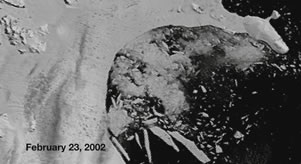 |
Starting on January 31, 2002, in a period of 35 days, this ice shelf completely disappeared. They could not figure out how in the world this happened so rapidly. They went back to try to figure out where they had gone wrong. That’s when they focused on those pools of melting water. Even before they could figure out what had happened there, something else started going wrong. When the floating sea-based ice cracked up, it no longer held back the ice on the land. The land-based ice then started falling into the ocean. It was like letting the cork out of a bottle. There’s a difference between floating ice and land-based ice. That’s like the difference between an ice cube floating in a glass of water, which when it melts doesn’t raise the level of water in the glass, and a cube sitting atop a stack of ice cubes, which melts and flows over the edge. That’s why the citizens of these pacific nations had all had to evacuate to New Zealand. |
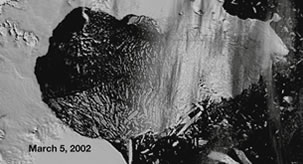 |
Greenland |
I want to focus on West Antarctica, because it illustrates two factors about land-based ice and sea-based ice. It’s a little of both. It’s propped on tops of islands, but the ocean comes up underneath it. So if the ocean gets warmer, it has an impact on it. If this were to go, sea levels worldwide would go up 20 feet (6 m.). They’ve measured disturbing changes on the underside of this ice sheet. It’s considered relatively more stable, however, than another big body of ice that is roughly the same size - Greenland. Greenland would also raise sea levels almost 20 feet if it went.
|
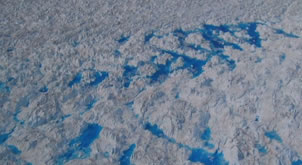 |
|
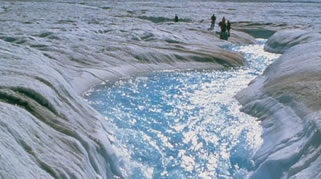 |
| A friend of mine just brought back some pictures of what is going on in Greenland right now; dramatic changes. These are the same kinds of pools that formed on this ice shelf and Antarctic. And the scientists thought that when that water seeps back into the ice, it would just refreeze. Actually what happens is that it just keeps going on. It tunnels to the bottom and makes the ice like Swiss cheese or like termites. This shows what happens to the crevasses. And when lakes form they create what are called moulins. Water goes down to the bottom and it lubricates where the ice meets the bedrock. See these people here for scale? This is not on the edge of Greenland. This is in the middle of the ice mass. This is a massive rushing torrent of fresh melt water tunneling straight down through the Greenland ice to the bedrock below. To some extent there has always been seasonal melting and moulins have formed in the past, but not like now. | |
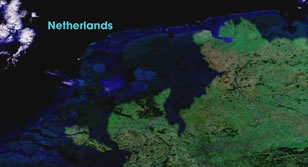 |
Impact of 20 Foot Rise in Sea Level Tony Blair’s scientific advisor has said that because of what is happening in Greenland right now, the maps of the world will have to be redrawn. If Greenland broke up and melted, or if half of Greenland and half of West Antarctica broke up and melted, this is what would happen to the sea level in Florida. This is what would happen in the San Francisco Bay. A lot of people live in these areas. The Netherlands, the low-countries: absolutely devastating. The area around Beijing is home to tens of millions of people. Even worse, in the area around Shanghai, there are 40 million people. Worse still, Calcutta and, to the East Bangladesh the area covered includes 50 million people. Think of the impact of a couple hundred thousand refugees when they are displaced by an environmental event and then imagine the impact of a hundred million or more. Here is Manhattan. This is the World Trade Center Memorial Site. After the horrible events of 9/11 we said never again. But this is what would happen to Manhattan. They can measure this precisely, just as the scientists could predict precisely how much water would breach the levy in New Orleans. The area where the World Trade Center Memorial is to be located would be under water. Is it possible that we should prepare against other threats besides terrorists? Maybe we should be concerned about other problems as well. |
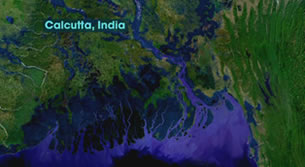 |
|
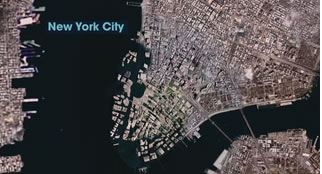 |